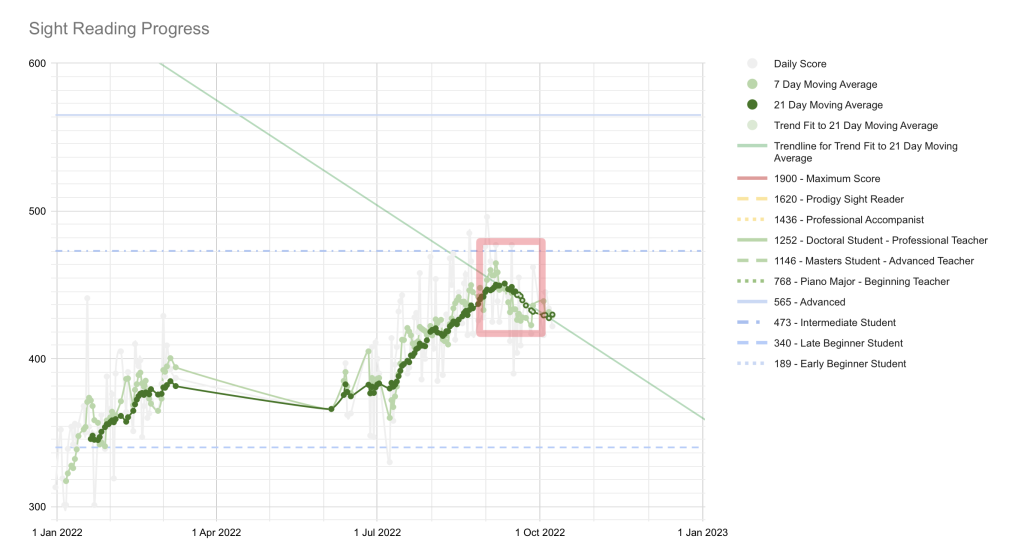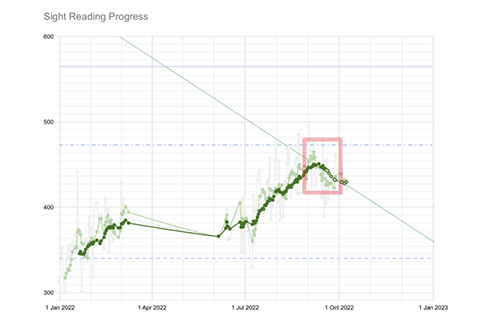Background
Conventional wisdom for the best way to practice sight reading is to just find material and keep reading. I said as much in my last post on the topic.
The challenge as a beginner is that it is difficult to identify pieces of music that are at your level. You need pieces that will challenge you while not being either too easy or too difficult.
Another important point is that you need to push yourself to sight read at a consistent tempo; ideally the actual tempo of the piece. This is hard to do on your own and one of the main reasons why lessons are mentally exhausting… your teacher will really push you to sight read at tempo and without stopping.
I have previously been working through three areas of focus in order to improve my sight reading:
- Shape recognition: understanding what you’re reading and trying to chunk stuff together.
- Never stopping: reading under pressure in a way that only either supervision by an app or another human can do.
- Proprioception / Kinaesthesia: improving spatial awareness at the keyboard.
Along the way I used Piano Marvel’s Standard Assessment of Sight Reading to score my progress so I could see how things were progressing.
To address each of those three areas of focus I used a combination of materials from both my teacher and Piano Marvel.
- Shape Recognition: Paper sheet music exercises from my teacher that are each designed to drive home a chord shape/progression.
- Never stopping: Playing through various ‘challenges’ in Piano Marvel where you can’t get to the next piece until get the current piece to 80% or better. One I achieved 80% (normally a couple of play through) I’d just move on regardless of how it sounded.
- Proprioception / Kinaesthesia: Sheet music exercises from my teacher. I really made an effort here to do 10-15 minutes per day of dedicated and mindful “don’t look down” exercises where you cannot look at the keyboard under any circumstance.
The rigour of this regime produced good results. Quantitatively I was improving my SASR score by about 1 to 1.2 points per day. Subjectively I noticed a significant improvement in both my score comprehension / ability to chunk things together and also my ability to work under pressure.
The Experiment
I decided to change my routine to just follow the conventional wisdom for three weeks to see what would happen.
There are four other people in my household learning piano and they all have plenty of pieces laying on the piano that I’ve not played. I thought I would just flick through their books, play whatever looked achievable as best as I could judge.
What I stopped doing:
- Dedicated time for shape recognition.
- Dedicated time for proprioception.
- Dedicated time for playing through pieces to a ‘good enough’ level under time pressure and moving on. Ironically the fact that Piano Marvel is full of cheesy trash music really helps this. Believe me, you don’t want to perfect anything it gets you to play.
What I started doing:
- Picking up pieces from other family members and reading through them at my own pace.
What I kept doing:
- Measuring my progress (mostly) daily with SASR.
The Results
The results were catastrophic.

I was on track to hit intermediate at the end of September 2022.
My SASR score reversed its trajectory and started going backwards.
Subjectively, I could feel my newly gained sight reading / spatial awareness skills slipping away daily. On one hand I regretted doing this because it was really setting me back; on the other hand I liked doing it as data like this is really helpful to myself and other people learning the piano.
When I returned to the “Don’t Look Down” exercses a few days ago I found that my ability to power through five pages of them with ease to be severely reduced and I was having to guess intervals or cheat and look down.
When I returned to going through random Piano Marvel trash, I mean pieces, I found each score confronting with my immediate thought being that I cannot possibly play this piece at that tempo. A month ago I was so used to just chewing through half a dozen new pieces per day that I didn’t care.
While I was left to my own devices without the rigour of an app forcing me to bring a piece of a level at the correct tempo for the piece I would often vary the tempo to focus on playing the correct notes, as opposed to keeping the beat and just dropping what I can’t play to keep going at all costs.
Other people might be more disciplined be able to do this without a teacher or an app, but I’m not.
I’m back on the wagon now so I need to try and turn that trend line back to the old trajectory which is going to be a few weeks of hard work.
I’ll write another post on sight reading in a month to see where I am at trend wise.
